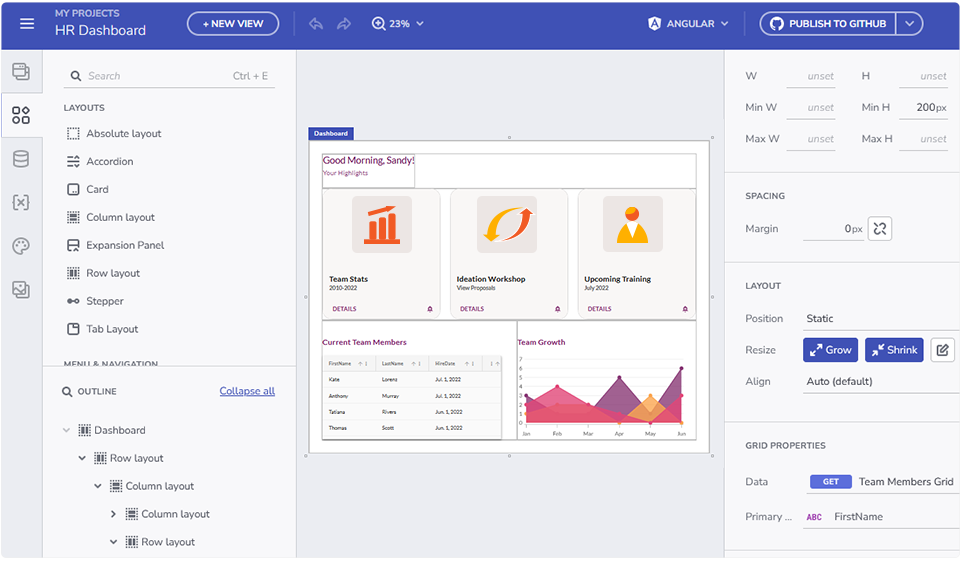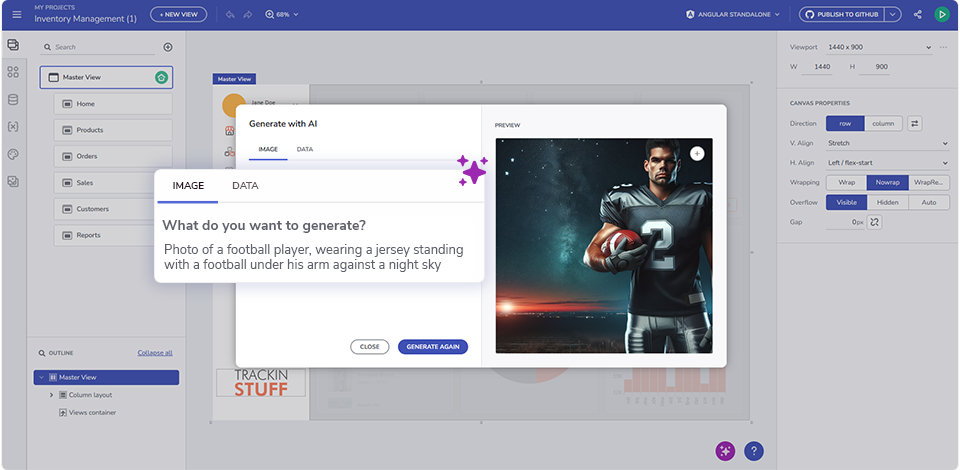

Guide: Eliminating Low-Code Challenges and Mitigating Risks
Low-code platforms come with security concerns. But these shouldn’t stop you from taking advantage of low-code technology and benefiting from accelerated application development with little or no coding knowledge. Instead, you should understand the key low-code challenges and risks and implement appropriate mitigation strategies.
Low-code development helps you build the applications you need without extensive coding knowledge and at a reduced time and cost. However, like any technology, low-code platforms sometimes come with their own set of risks and low-code challenges. And mitigating these low-code risks is key to creating custom business solutions that boost productivity without putting your business at risk.
This guide will discuss the top low-code security risks and vulnerabilities and the best practices for mitigating them that you should consider.
Key Low-Code Challenges in Low-Code Adoption
Some low-code challenges that organizations face during the low-code adoption process include:
Customization Limitations
Low-code platforms offer a predefined set of features that allow you to achieve business agility and improve your developers’ productivity (and even citizen developers). The drawback here is that you may run into problems when attempting to go beyond what they offer out of the box.
As a result, low-code solutions can be oversimplified or may not effectively address complex business processes. These solutions often do not offer advanced features or deep customizations required for highly specialized use cases. For example, a less comprehensive, low-code platform may lack the ability to create a dashboard or data visualization component specific to your business.

When trying to implement very specific or complex business logic, you may find that the platform either can’t handle it natively or requires complex configurations.
How to mitigate customization limitations?
A hybrid approach is one way to overcome constraints on how much you can tailor low-code applications to your specific needs.
Choose a flexible, low-code platform with a wide range of customization options, including adding custom code to extend functionality. This approach lets you enjoy the speed of low-code development while enabling custom customization.
Integration with Existing Systems
Integrating any new digital tool with existing ones is important so that all your applications can share data seamlessly and work together to solve business needs. However, sometimes integrating low-code solutions with existing systems for smooth operation can also pose certain low-code challenges.
Low-code platforms usually come with pre-built connectors that allow the integration of their applications with common, widely used services like CRM platforms and cloud storage systems. However, these solutions may not integrate easily with legacy systems or more complex environments.
The low-code platforms assume that integrations will be made with standard API protocols like RESTful services and standardized authentication methods like OAuth 2.0. So, integration can be challenging if your organization uses custom-built APIs or integrates with a third party that doesn’t use these standard protocols.
This is why if you use legacy systems (older systems and databases), your organization may be unable to integrate low-code tools with your existing systems. Many older technologies lack APIs, RESTful services, or the capacity to accept data in modern JSON or XML.
How to mitigate integration challenges?
One way to overcome such low-code challenges is to design and use APIs. For example, if you have a legacy ERP system that doesn’t use standard protocols, your developers can wrap it in a RESTful API and then call those API endpoints from a low-code platform. This allows them to easily pull data from the ERP system into the new application.
For more complex integration, a middleware platform can orchestrate data flow between the low-code platform and other systems.
Vendor Lock-In
As your organization evolves, migrating to a more powerful platform may become necessary to meet various demands (such as handling more traffic, for example). However, low-code adoption can cause vendor dependency and make it difficult to switch platforms when that becomes necessary.
One reason low-code development makes migration to new platforms difficult is that low-code platforms rely on proprietary technologies that are unique to them.
For example, a low-code platform may use a proprietary schema for data storage, which ties the data structure to its own database or backend. Moving this data to a different system would require custom development, which would be time-consuming and costly.
Because migrating away from the platform’s data storage model would be difficult and may require significant resources, you’ll find yourself “locked in”- forced to continue using the platform when you really need to migrate to a more powerful platform.
How to mitigate vendor lock-in?
When choosing a low-code platform, prioritize solutions that use open standards and common data formats. This facilitates data exchange between systems, making it easier to migrate in the future if needed.
Also, when using low-code platforms avoid over-customizing with platform-specific components or proprietary extensions. Instead, focus on industry-standard components.
Risks of Low-Code Platforms and How To Mitigate Them
The most notable low-code risks have to do with security, data management, and compliance. Let’s examine each of them in detail.
Low-Code Security Risks
Unlike traditional software development, low-code development does not allow you to apply your own security controls. And built-in low-code security controls may not be very robust, introducing security risks. In addition, the fast developmental cycles can cause users to overlook key security aspects, leaving security vulnerabilities.
Common security risks of low-code platforms include:
Insufficient Access Control
Low-code platforms are designed to make it easy to build apps. Because of this simplicity, they may assign broad permissions by default (such as an admin having full control over everything). This can result in unauthorized users accessing sensitive data or system functions.
How to mitigate insufficient access control risk?
One way to mitigate access control low-code security risks is to configure role-based access controls (RBAC). Clearly define roles and grant permissions based on user tasks, ensuring that sensitive operations are only accessible to the appropriate roles.
When assigning permissions to roles, follow the principle of least privilege. This means you should give users only the minimum level of access necessary to perform their tasks.
Also, regularly audit your access control configurations to ensure that users are assigned the correct permissions and to track changes to roles or privileges. This helps identify misconfigurations or unauthorized changes.
Data Leakage
Low-code platforms interact with external systems to retrieve or store data. If integrations are not properly configured, they can lead to data leakage. For example, if an API that a low-code app uses to retrieve user data from a cloud service lacks proper authentication, an attacker could find the endpoint and access private user data without needing any credentials.
How to mitigate data leakage security risks?
Secure API management and data encryption can help you mitigate these risks.
When integrating with third-party services, use secure authentication methods to authenticate and authorize communication between systems. Proper input validation must also be applied to ensure that only necessary data is shared with third-party services.
It’s important to note that encryption should be used for both data at rest and in transit. This ensures attackers cannot read data if they intercept it or gain access to the underlying storage.
Insufficient Security Logging and Monitoring
Low code focuses on speed and simplicity. However, the rapid development cycle can cause users to overlook certain security best practices, such as logging (recording what happens within the application) and monitoring (watching the app’s behavior to detect anomalies).
Insufficient logging and monitoring make detecting security breaches or abnormal behavior harder. For example, if an attacker bypasses authentication and steals sensitive data, the security breach may go unnoticed if there’s no logging to show unusual access patterns.
How to mitigate insufficient security logging and monitoring?
Ensuring detailed and secure action-based logging and implementing real-time monitoring tools to flag suspicious behavior help mitigate this security risk.
Make sure that the application can capture all user actions and system events, such as login attempts (both successful and failed attempts), data accesses, , deletions, modifications, , role assignments, and more. These logs can help you catch unauthorized access attempts and suspicious behavior.
Inadequate Security Testing
In traditional software development, developers perform code reviews, unit testing, and security scans to identify vulnerabilities. However, this detailed testing may not happen in low-code environments because the platform generates much of the code. This can lead to unnoticed vulnerabilities in application security.
How to mitigate inadequate security testing risks?
Implementing security testing in low-code development can help you mitigate this risk. Perform security checks at every development stage, whether during design, prototyping, or the final build. Conduct threat modeling to identify low-code challenges, key risks, and security vulnerabilities. Conduct penetration testing by simulating real-world attacks to identify weaknesses.
App Builder offers an instant preview of generated code alongside the application design. This helps you understand the app’s logic and detect vulnerabilities.
Data Management Risks In Low Code
Managing and securing data in low-code environments present a range of low-code challenges, which include:
Poor Data Governance or Control
When different departments create their own apps using low-code platforms, there may be no centralized oversight (by IT leaders) regarding how data is accessed, processed, and stored within the app. Also, when business users create their own applications and data models based on their own workflows, they may not align with the broader organizational goals or definitions. Inconsistent data definition and uncontrolled data can compromise data quality and integrity, leading to problems in reporting, analysis, and decision-making.
How to mitigate poor data governance challenges?
Establishing clear data governance frameworks will help you mitigate this low-code risk. Specific strategies include standardizing data management practices. Establish standards for data entry, naming conventions, data storage, and more, and ensure that these standards are followed when developing low-code apps. Consider implementing data classification policies to categorize data based on sensitivity (e.g., public, internal, confidential, etc.).
In addition, define who is responsible for each type of data within the organization and assign data custodians to oversee data collection, use, and maintenance.
Interoperability Problems
Low-code applications may not easily integrate with an organization’s broader data architecture, especially when it uses legacy systems, diverse databases, or hybrid cloud infrastructure.
A lack of integration can result in data silos, where different parts of the organization have inconsistent data. This can undermine analytics, reporting, and decision-making.
How to mitigate strategies for interoperability issues?
One way to mitigate interoperability low-code risk is to enforce integration best practices to ensure data flows between systems. This involves adopting standardized APIs and following industry best practices for authentication and encryption. Standard data formats like JSON and XML should also be utilized. Using established standards reduces the risk of incompatibility.
Consider using automated synchronization tools to detect mismatches and implement rules for handling data conflict (such as what should be done when data from two systems differs). In addition, opt for low-code vendors that support standard integration protocols. Check that the platform supports modern cloud-based systems as well as legacy on-premise databases.
App Builder, for example, supports standardized APIs for easy integration with external data sources. It is compatible with popular design tools like Sketch and Figma, allowing you to import designs and convert them into functional applications.
Compliance and Regulatory Risks
Regulatory compliance is a must for organizations that handle sensitive data (or personal data). There are regulations that impose strict guidelines on how personal data should be collected, processed, and stored. These include the GDPR (General Data Protection Regulation), CCPA (California Consumer Privacy Act), and HIPAA (Health Insurance Portability and Accountability Act).
The challenge is that citizen developers may not be fully aware of compliance requirements, leading to violations of data regulations. This can result in hefty fines, legal penalties, and reputational damage.
How to mitigate compliance and regulatory low-code risks?
Mitigating compliance and regulatory low-code risks starts with understanding appliance compliance requirements. Before building the app, identify the regulations for your territory and specific industry.
Then, go for low-code platforms with built-in compliance features such as encryption and data masking. You should also integrate compliance checks into app development.
Finally, implement strong data privacy and protection controls. For example, only collect the minimum amount of data necessary for the intended purpose, consider replacing personal identifiers with pseudonyms, encrypt sensitive data, and more.
You may also like App Builder AI: How Does it Streamline App Development?
Conclusion and Article Takeaways
Low-code platforms come with security concerns. But these shouldn’t stop you from taking advantage of low-code technology and benefiting from accelerated application development with little or no coding knowledge. Instead, you should understand the key low-code challenges and risks and implement appropriate mitigation strategies.
Implementing the low-code risk mitigation strategies discussed above will help you build robust low-code applications that remain secure, scalable, and compliant. These strategies include configuring role-based access controls, using secure authentication methods and data encryption, and ensuring activity logging.

Choosing the right low-code platform is an essential aspect of these strategies. This is where App Builder comes in.
In essence, App Builder is a low-code platform with a simple drag-and-drop interface that enables users to design and build applications without extensive coding. It has features that mitigate the low-code risks and low-code challenges, and all the apps built using this tool can be further customized. It supports standardized APIs for easy integration and has built-in features for compliance (such as encryption).
Book a Demo and see how App Builder can help you stay ahead!


